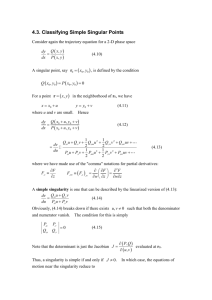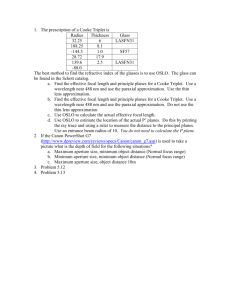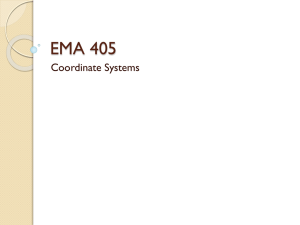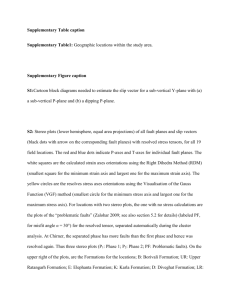(W Bohemia): significance of the „abnormal“ 1997 swarm
advertisement
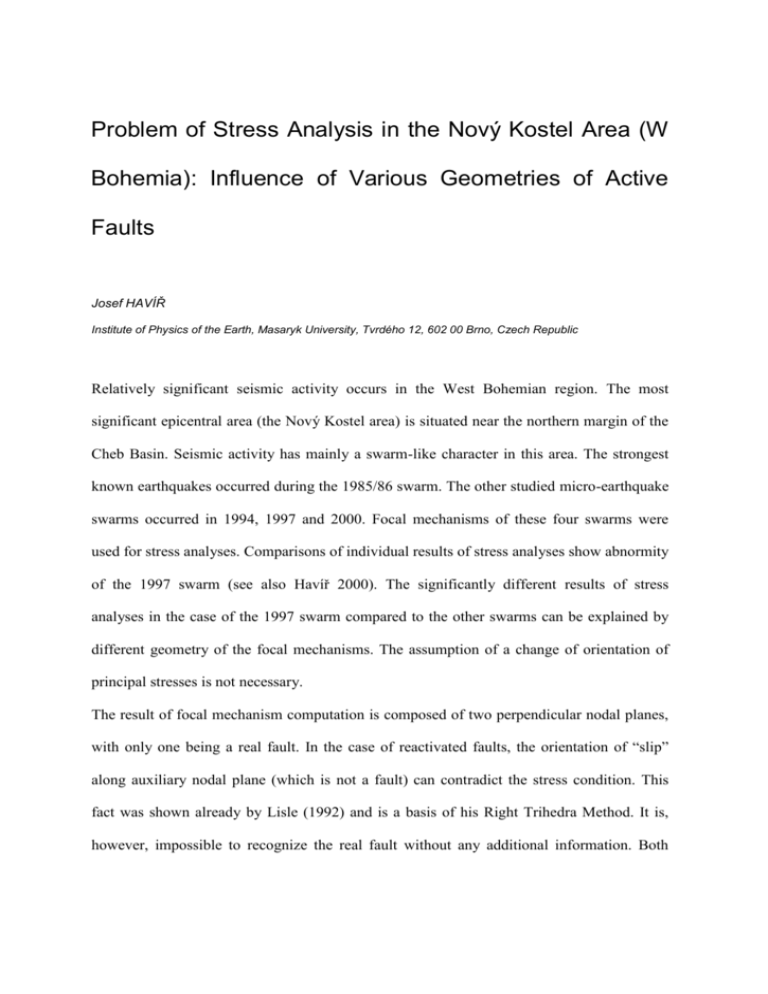
Problem of Stress Analysis in the Nový Kostel Area (W Bohemia): Influence of Various Geometries of Active Faults Josef HAVÍŘ Institute of Physics of the Earth, Masaryk University, Tvrdého 12, 602 00 Brno, Czech Republic Relatively significant seismic activity occurs in the West Bohemian region. The most significant epicentral area (the Nový Kostel area) is situated near the northern margin of the Cheb Basin. Seismic activity has mainly a swarm-like character in this area. The strongest known earthquakes occurred during the 1985/86 swarm. The other studied micro-earthquake swarms occurred in 1994, 1997 and 2000. Focal mechanisms of these four swarms were used for stress analyses. Comparisons of individual results of stress analyses show abnormity of the 1997 swarm (see also Havíř 2000). The significantly different results of stress analyses in the case of the 1997 swarm compared to the other swarms can be explained by different geometry of the focal mechanisms. The assumption of a change of orientation of principal stresses is not necessary. The result of focal mechanism computation is composed of two perpendicular nodal planes, with only one being a real fault. In the case of reactivated faults, the orientation of “slip” along auxiliary nodal plane (which is not a fault) can contradict the stress condition. This fact was shown already by Lisle (1992) and is a basis of his Right Trihedra Method. It is, however, impossible to recognize the real fault without any additional information. Both nodal planes must be thus taken into account during the stress analysis, although the geometry of auxiliary nodal planes represents wrong data put into the computation process. Most of the hypocentres fit to a NNW–SSE, steeply west-dipping narrow zone; the orientation of best-fitting plane is 262/80 (dip azimuth /dip angle). A similar result was published by Fischer and Horálek (2003). Bankwitz et al. (2003) inform about geomorphological indications of this zone and its southern prolongation, calling this generally NNW–SSE-striking structure the “Počátky-Plesná Zone” (PPZ). In the cases of individual swarms, the hypocentres of events of three swarms (1985/86, 1994 and 2000) fit well with the PPZ (see also Fischer and Horálek, 2003). Most part of the focal mechanisms has one nodal plane, the strike of which differs only slightly from the strike of the PPZ (difference less than 25°). These nodal planes can be thus identified as real faults and probably correspond to smaller faults forming the PPZ (R or P shears, see Bankwitz et al., 2003). Stress analyses based on focal mechanisms of the three discussed swarms (1985/86, 1994, 2000) show the σ1 dipping towards SE and σ3 orientated NE-SW. The hypocentres of events of the 1997 swarm do not fit to only a single individual plane. Fischer and Horálek (2000) determined two planes (57/53 and 111/62). Orientations of nodal planes of focal mechanisms vary significantly. Fischer and Horálek (2000) separated focal mechanisms into eight groups in the case of the 1997 swarm. Notwithstanding, general clockwise rotation of nodal planes can be observed in the case of the 1997 swarm. Strike of one nodal plane is mostly comparable with plane fitting the hypocentres of the foci of type B (plane 111/62, thus strike is 21°) determined by Fischer and Horálek (2000). The discussed nodal planes can be thus identified as real faults, at least in the case of the foci of type B (marked by Fischer and Horálek 2000). Geometry of these faults corresponds also to the orientation of principal stresses determined for data of other swarms. In the case of foci of type A (marked by Fischer and Horálek 2000), the situation is more complicated. The displacement along the discussed NNE–SSW- to NE–SW-striking faults is less probable than the displacement along faults with orientations similar to that of the PPZ. The observed occurrence of this displacement can be explained by sudden decrease of isotropic part of the stress tensor. References BANKWITZ P., SCHNEIDER G., KÄMPF H. and BANKWITZ E., 2003. Structural characteristics of epicentral areas in Central Europe: study case Cheb Basin (Czech Republic). Journal of Geodynamics, 35, 1-2: 5-32. FISCHER T. and HORÁLEK J., 2000. Refined locations of the swarm earthquakes in the Nový Kostel Focal Zone and spatial distribution of the January 1997 swarm in Western Bohemia, Czech Republic. Studia Geophysica et Geodetica, 44: 210-226. FISCHER T. and HORÁLEK J., 2003. Space-time distribution of earthquake swarms in the principal focal zone of the NW Bohemia/Vogtland seismoactive region: period 1985-2001. Journal of Geodynamics, 35, 1-2: 125-144. HAVÍŘ J., 2000. Stress analyses in the epicentral area of Nový Kostel (Western Bohemia). Studia Geophysica et Geodetica, 44: 522-536. LISLE R.J., 1992. New method of estimating regional stress orientations: application to focal mechanism data of recent British earthquakes. Geophys. J. Int., 110: 276-282.
